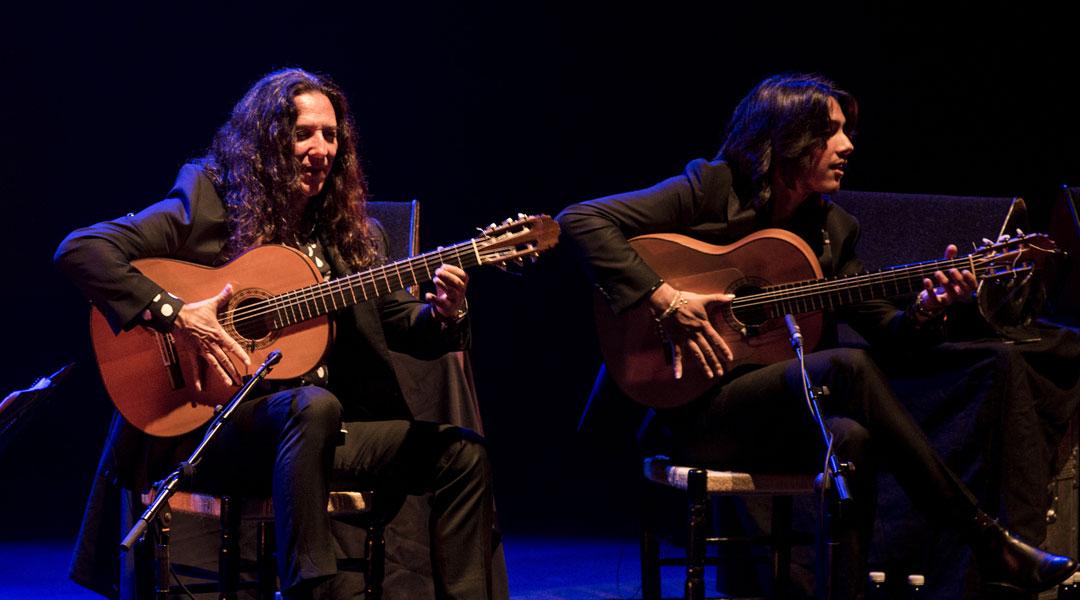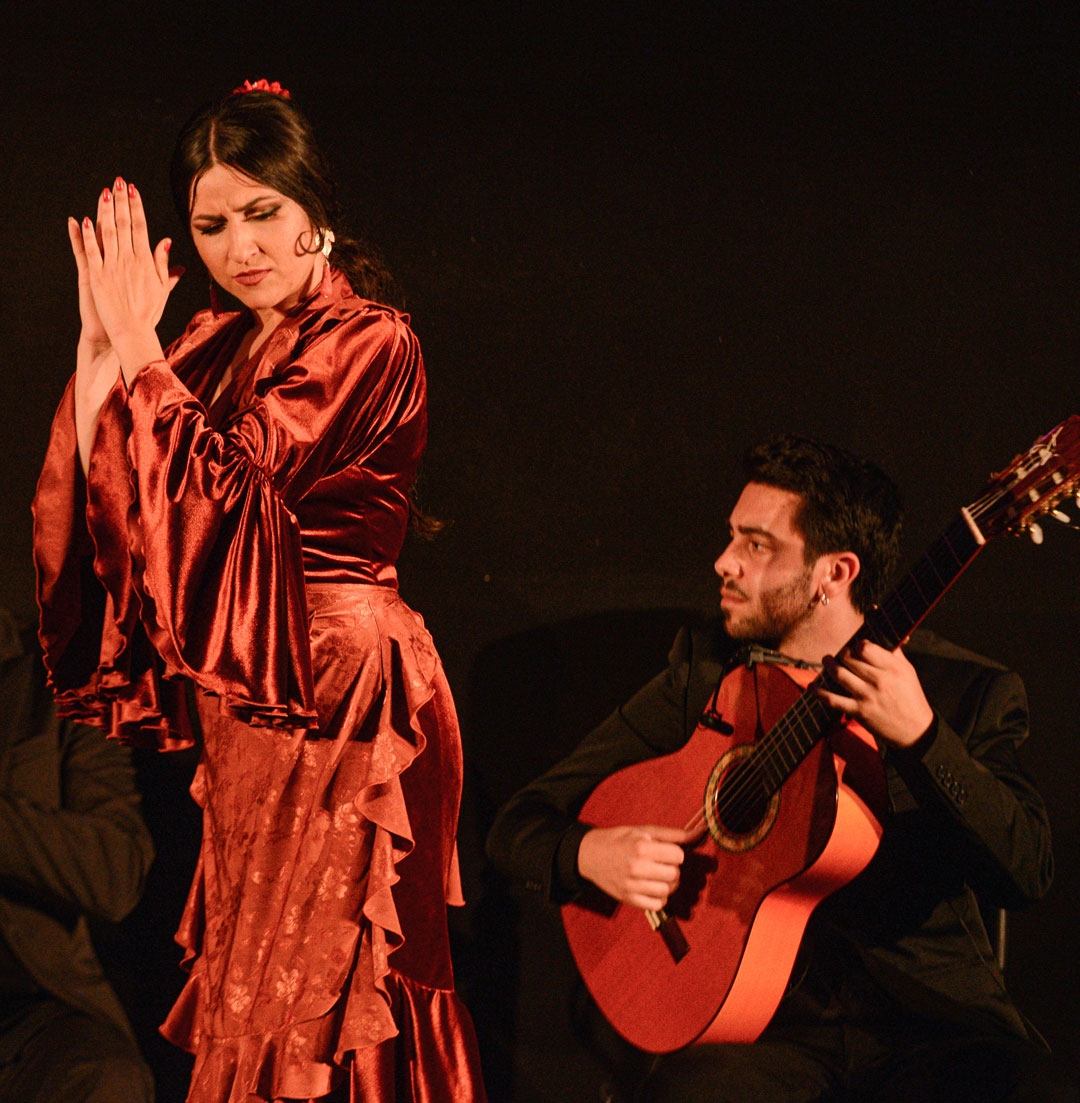Spanish guitarists
Flamenco that transcends borders

With the unforgettable Paco de Lucía as a role model, new generations of guitarists continue to move increasingly more diverse audiences. As well as accompanying flamenco dancers and singers, these musicians stand out as soloists. Deeply rooted in flamenco tradition, they have known how to push the boundaries of the genre towards new and surprising musical realms.
Since flamenco guitar has become the star of solo performances, many flamenco guitarists have stood out over the years because of their talent as soloists. It was in the 1960s and 1970s when flamenco art experienced a major revolution: guitars not only accompanied flamenco dancers and singers but also took centre stage as soloists. Paco de Lucía was, undoubtedly, one of the leading figures at the time, alongside Manolo Sanlúcar, Serranito, Paco Cepero and Pepe Habichuela—these last three remained active at the age of 80!—. Since then, there has been a succession of masters and disciples, a chain of inspiration and learning that has borne diverse and very personal fruits, while flamenco music has been influenced by other genres, from jazz or classical music to rock or Latin rhythms. These are some of the most outstanding artists on the current flamenco scene.
Tomatito
Camarón’s guitarist
He was born in 1958 in the fishing neighbourhood of Pescadería, in Almería. The son, grandson and nephew of guitarists, Tomatito was just 20 years old when he recorded, alongside the iconic Camarón de la Isla, an album that was a turning point for flamenco music: La leyenda del tiempo. This album, which incorporated electronic sounds—something unheard of at the time—, brought together figures like Kiko Veneno or brothers Ricardo and Rafael Amador, founders of the famous band Pata Negra. Even though it wasn’t a massive success at the time, today it is considered the best album in the history of flamenco rock. Tomatito remained by Camarón’s side until the flamenco singer passed away. Then he established himself as a solo artist. His career hasn’t stopped: at the age of 68, he’s one of the most well-known flamenco artists both inside and outside of Spain. The author of a dozen albums, he has won two Latin GRAMMY™ Awards (the last for his album Spain Forever, alongside the brilliant Caribbean pianist Michel Camino), a Max Award for the Performing Arts and a Gold Medal of Merit in the Fine Arts, among others.
Vicente Amigo
Cordovan pride
Although he was born in Seville in 1967, he grew up in Córdoba, where he developed his musical career while going on international tours. He’s one of the most well-known and most awarded flamenco artists: he boasts, among others, several Premios de la Música for best flamenco artist and best flamenco composer, like the ones he received in 1997 for his album Poeta, a homage to Rafael Alberti. He has also won two Latin GRAMMY™ Awards: one in 2001 for Ciudad de las ideas (2002 Ondas Award for best flamenco work) and another in 2017 for Memoria de los sentidos. In 2025, the Academia de la Música granted him the Award for Best Flamenco Song for his Pasodoble a José Tomás. His extensive repertoire also includes collaborations with artists like Enrique Morente, Carmen Linares, Alejandro Sanz and even Sting.
Gerardo Núñez
International soloist
This artist, born in Jerez in 1961, amazes and moves his audience with his technical prowess and his ability to bring together flamenco tradition, jazz and classical music. He has collaborated with famous flamenco dancers and singers, like Tío Borrico, Mario Maya, Carmen Linares and, obviously, his artistic partner Carmen Cortés. He is well-renowned internationally as a soloist; in fact, he’s the only flamenco guitarist to receive a medal from the Tchaikovsky Moscow Conservatory. One of the most moving moments in his career was when he played his own songs with the Chicago Symphony Orchestra at Millennium Park.
Rafael Riqueni
Early talent
He was born in 1962 in the neighbourhood of Triana, Seville, the cradle of flamenco. At the tender age of 12, he already wowed audiences with his skilful performances. At 14, he won his first two awards as a soloist. He’s the author of songs that have turned into flamenco classics, like Juego de niños, Mi tiempo, Suite Sevilla or Alcázar de cristal. Years later, he hit pause on his career due to health issues and addictions. Nevertheless, he managed to recover, as is reflected in the documentary Riqueni, directed by his friend Paco Bech. In 2020, he received the Giraldillo de la Ciudad de Sevilla award for his artistic career.
Juan Manuel Cañizares
Flamenco and classical music
This prestigious teacher, researcher, composer and artist born in 1966 in Sabadell (Barcelona) has published several of his own albums—like Suite Iberia - Albéniz por Cañizares—and hundreds of collaborations with other musicians. He has also received many awards, including the Premio Nacional de Interpretación by the Ministry of Culture and Sports, for his performing ability to bring together different stylistic traditions on the guitar while breaking the barriers between classical music and flamenco, as well as for disseminating Spanish guitar internationally. He has worked with renowned artists like Paco de Lucía, Enrique Morente, Camarón de la Isla, Joan Manuel Serrat, Alejandro Sanz or Peter Gabriel. One of the most memorable moments of his career was when he played Concierto de Aranjuez with the Berlin Philharmonic, directed by Sir Simon Rattle.

Young guitarist Yeray Cortés during the Royal Flamenco cycle at Teatro Real in 2019, alongside flamenco dancer Gema Moneo. ©Juanlu Vela – Teatro Real
Diego del Morao
A legacy from Jerez
He’s the son of Moraíto Chico (1956-2011), one of the most influential guitarists of his generation. Born in 1978 in Jerez de la Frontera, he was one of the 20 artists who took part in the tribute album to Paco de Lucía, Entre 20 Aguas, 2015 Latin GRAMMY™ for best flamenco album, produced by Javier Limón. He has accompanied great performers like José Mercé, Enrique Morente, Diego el Cigala or Niña Pastori. Diego del Morao is part of a talented and awarded generation of flamenco guitarists born in the 1970s and the beginning of the 1980s, greatly influenced by world music like Niño Josele, Antonio Rey or Daniel Casares.
Yerai Cortés
Riding the new flamenco wave
Born in Alicante in 1995, he’s part of the new generation of flamenco guitarists, capable of preserving the genre’s roots while also starting out on surprising and innovative journeys. Many know him from the two-time Goya Award-winning documentary in 2025 (best original song and best documentary film): La guitarra flamenca de Yerai Cortés. It was the directorial debut of Antón Álvarez, better known as C. Tangana, who the young guitarist accompanied during his tour Sin cantar ni afinar.
Antonia Jiménez
From a female perspective
Female guitarists still have a tough time taking up space on the flamenco music scene, even though their technique and art live up to those of the best soloists. A good example of this is flamenco guitarist Antonia Jiménez, who found success more easily in Japan than in her homeland. Born in Cádiz in 1972, her career spans more than 25 years—most of them on international stages—and she is considered one of the leading female role models of flamenco guitar. She has accompanied great names like Carmen Linares, Rocío Molina or Manuel Liñán. She has also played alongside another leading female flamenco guitarist: Marta Robles (Sevilla, 1976), who, with solid academic training, is part of the female quartet Las Migas, which has already won a Latin GRAMMY™.
The guitar, the most played instrument in Spain, attracts so much talent that it’s impossible to mention all the artists who have won awards over the years in the world of flamenco. The current landscape is also full of rising stars, like Mercedes Luján (Lorca, Murcia, 1987), Juan Habichuela Nieto (Granada, 1989), Alejandro Hurtado (Alicante, 1994), José del Tomate (the son of Tomatito, born in Almería in 1997), Laura Espert (Jerez de la Frontera, 1997) and David de Arahal (Seville, 2000).


